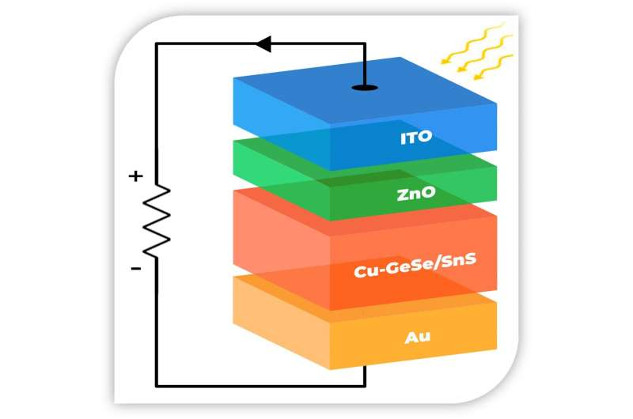
After six years of development, the Dutch tech startup's solar-powered EV, named 'the 0,' is ready to make its debut. This innovative vehicle boasts the ability to go months without needing a recharge, setting a new standard for efficiency in electric transportation.
Researchers from Lehigh University have developed a new quantum material that could significantly revolutionize the efficiency of solar panels. This innovative material, combining copper, germanium selenide (GeSe), and tin sulfide (SnS), has demonstrated an external quantum efficiency (EQE) of up to 190%. This number surpasses the conventional efficiency limits, suggesting a breakthrough that could transform solar energy harvesting.
Understanding the Efficiency Breakthrough
Solar cells convert sunlight into electricity, and their effectiveness is gauged by the EQE, which traditionally maxes out at 100%. This 100% efficiency means each photon of light generates one electron of electricity. However, the new material developed at Lehigh uses a mechanism known as multiple exciton generation (MEG), where high-energy photons can produce more than one electron, thus pushing the efficiency beyond the 100% barrier.
What sets this material apart is its use of "intermediate band states" – specific energy levels within the material that enhance its ability to convert solar energy. These energy levels are ideally situated to exploit photons that conventional solar cells would waste. The material taps into a broader range of the solar spectrum by absorbing additional light in the infrared and visible spectrums, thereby boosting electricity generation.
The Science Behind the Innovation

Schematic of the thin-film solar cell with CuxGeSe/SnS as the active layer. Credit: Ekuma Lab / Lehigh University
The material's impressive performance is rooted in the precise structural manipulation at the molecular level. By inserting copper atoms into layers of GeSe and SnS, the researchers have created a tightly bound, two-dimensional structure that enables unique photon interactions with the material. These interactions occur within van der Waals gaps—tiny spaces between the layers of the material where the copper atoms reside.
Through extensive computer simulations and experimental methods, the team has honed a technique that allows for the exact placement of copper atoms, minimizing unwanted effects like clustering, which could compromise the material's performance.
Privind în perspectivă: provocări și oportunități
The development of a new quantum material with up to 190% quantum efficiency by researchers at Lehigh University could significantly advance solar-powered transportation, including cars, trucks, and buses.
This breakthrough material, capable of efficiently capturing a broad spectrum of sunlight, addresses the current limitations of solar-powered vehicles by providing sufficient energy for heavier and long-distance travel without reliance on fossil fuels.
Integrating these high-efficiency solar cells into vehicle designs offers the possibility of reducing carbon emissions dramatically, particularly in heavy-use vehicles like buses and trucks, where fuel costs and environmental impact are significant concerns.
As these advanced solar cells are further developed for practical use, they could transform economic and environmental dynamics globally. Reducing operational vehicle costs and carbon emissions could lead to substantial financial savings and improved public health through cleaner air.
Moreover, shifting towards solar-powered vehicles would decrease global dependence on oil, enhance geopolitical stability, and promote job creation in renewable energy sectors. This shift represents a crucial step towards sustainable global transportation, aligning with broader environmental goals and paving the way for a cleaner, more sustainable future.
While the results are promising, a path is ahead before commercializing this material. Integrating this new quantum material into existing solar energy systems requires further research and development. Although advanced, the production process needs to be scaled up for practical application in the solar power industry.
The potential benefits of this technology are vast. By significantly increasing the efficiency of solar cells, we can make strides toward more sustainable energy solutions, reducing our reliance on fossil fuels and decreasing the environmental impact of energy production.
The work of Professor Chinedu Ekuma and his team at Lehigh University represents a significant leap forward in the field of photovoltaics. Their development challenges existing limits and opens up new avenues for the future of renewable energy. As this technology progresses, it could lead to more affordable and efficient solar power systems, making solar energy more accessible worldwide and helping to sustain global energy needs.
Despre autor
 Robert Jennings este co-editor al InnerSelf.com împreună cu soția sa Marie T Russell. A urmat Universitatea din Florida, Institutul Tehnic de Sud și Universitatea din Florida Centrală cu studii în domeniul imobiliar, dezvoltare urbană, finanțe, inginerie arhitecturală și învățământ primar. A fost membru al Corpului Marin al SUA și al Armatei SUA, după ce a comandat o baterie de artilerie de câmp în Germania. A lucrat în finanțare imobiliară, construcții și dezvoltare timp de 25 de ani înainte de a înființa InnerSelf.com în 1996.
Robert Jennings este co-editor al InnerSelf.com împreună cu soția sa Marie T Russell. A urmat Universitatea din Florida, Institutul Tehnic de Sud și Universitatea din Florida Centrală cu studii în domeniul imobiliar, dezvoltare urbană, finanțe, inginerie arhitecturală și învățământ primar. A fost membru al Corpului Marin al SUA și al Armatei SUA, după ce a comandat o baterie de artilerie de câmp în Germania. A lucrat în finanțare imobiliară, construcții și dezvoltare timp de 25 de ani înainte de a înființa InnerSelf.com în 1996.
InnerSelf este dedicat împărtășirii informațiilor care le permit oamenilor să facă alegeri educate și perspicace în viața lor personală, pentru binele comunității și pentru bunăstarea planetei. Revista InnerSelf se află în cei peste 30 de ani de publicare fie în format tipărit (1984-1995), fie online ca InnerSelf.com. Vă rugăm să ne sprijiniți munca.
Creative Commons 4.0
Acest articol este licențiat sub o licență Creative Commons Atribuire-Distribuire identică 4.0. Atribuie autorul Robert Jennings, InnerSelf.com. Link înapoi la articol Acest articol a apărut inițial pe InnerSelf.com




























